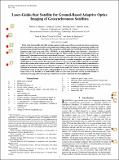Laser-Guide-Star Satellite for Ground-Based Adaptive Optics Imaging of Geosynchronous Satellites
Author(s)
Marlow, Weston A.; Carlton, Ashley K.; Yoon, Hyosang; Clark, James R.; Haughwout, Christian Alexander; Cahoy, Kerri; Males, Jared R.; Close, Laird M.; Morzinski, Katie M.; ... Show more Show less
DownloadSubmitted version (1.084Mb)
Terms of use
Metadata
Show full item recordAbstract
In this study, the feasibility and utility of using a maneuverable nanosatellite laser guide star from a geostationary equatorial orbit have been assessed to enable ground-based, adaptive optics imaging of geosynchronous satellites with next-generation extremely large telescopes. The concept for a satellite guide star was first discussed in the literature by Greenaway and Clark in the early 1990s ("PHAROS: An Agile Satellite-Borne Laser Guidestar," Proceedings of SPIE, Vol. 2120, 1994, pp. 206-210), and expanded upon by Albert in 2012 ("Satellite-Mounted Light Sources as Photometric Calibration Standards for Ground-Based Telescopes," Astronomical Journal, Vol. 143, No. 1, 2012, p. 8). With a satellite-based laser as an adaptive optics guide star, the source laser does not need to scatter, and is well above atmospheric turbulence. When viewed from the ground through a turbulent atmosphere, the angular size of the satellite guide star is much smaller than a backscattered source. Advances in small-satellite technology and capability allowed the revisiting of the concept on a 6UCubeSat, measuring 10 × 20 × 30 cm. It is shown that a system that uses a satellite-based laser transmitter can be relatively low power (∼1 W transmit power) and operated intermittently. Although the preliminary analysis indicates that a single satellite guide star cannot be used for observing multiple astronomical targets, it will only require a little propellant to relocate within the geosynchronous belt. Results of a design study on the feasibility of a small-satellite guide star have been presented, and the potential benefits to astronomical imaging and to the larger space situational awareness community have been highlighted.
Date issued
2017-03Department
Massachusetts Institute of Technology. Department of Aeronautics and Astronautics; Lincoln LaboratoryJournal
Journal of Spacecraft and Rockets
Publisher
American Institute of Aeronautics and Astronautics (AIAA)
Citation
Marlow, Weston A. et al. "Laser-Guide-Star Satellite for Ground-Based Adaptive Optics Imaging of Geosynchronous Satellites." Journal of Spacecraft and Rockets 53, 4 (March 2017): A33680 © 2016 Massachusetts Institute of Technology
Version: Original manuscript
ISSN
0022-4650
1533-6794